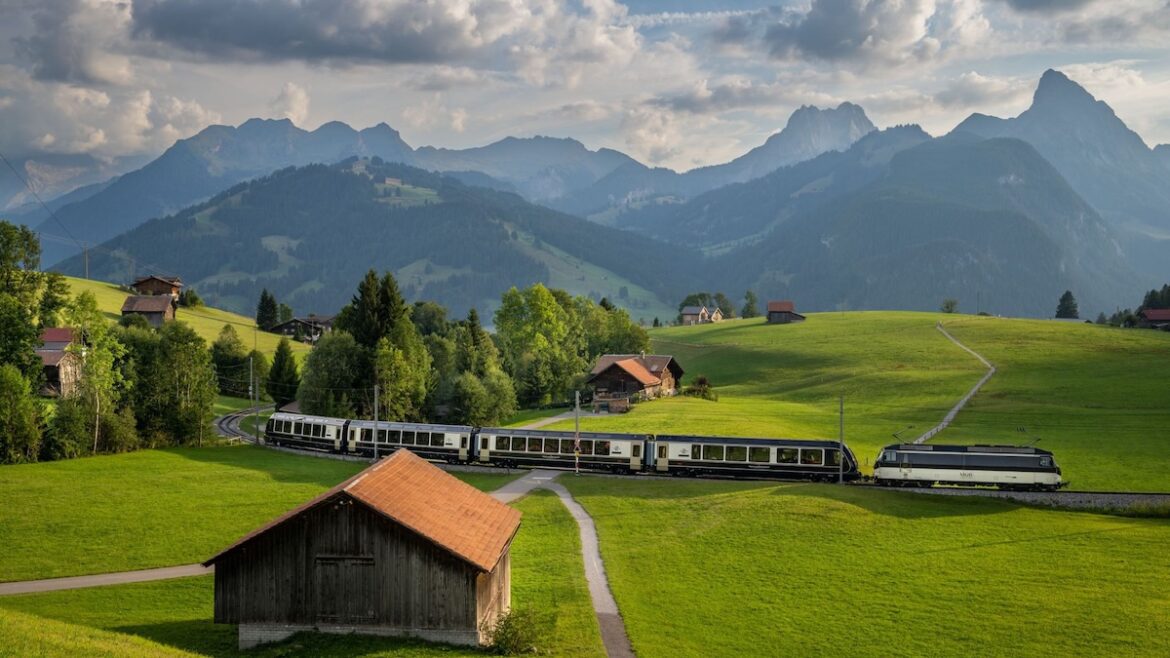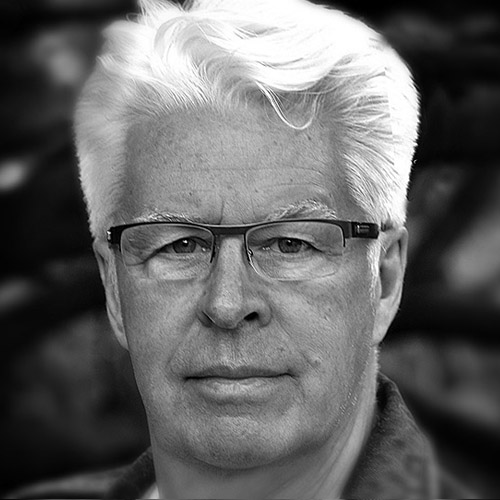Première classe on the Eurostar Train
What could possibly be more exciting than a Grand Train Tour of Switzerland with the promise of première classe (of course), panoramic carriages, gorgeous scenery, impeccable service, concierged luggage, delicious comestibles with a different region and hotel each night? Not an aircraft in sight. Hilaire Belloc wrote ‘The prospect of refreshment at the charges of another is an opportunity never to be neglected by men of clear commercial judgment.’ How very right he was.
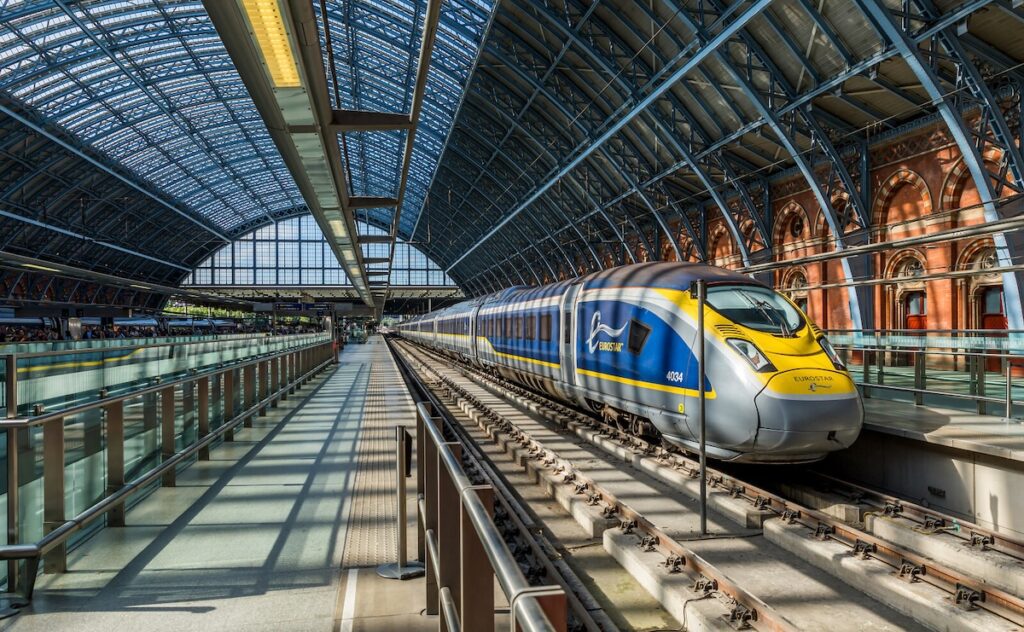
Murder on the 8.01?
It started at my favourite railway station in all the world – St Pancras – that Victorian Gothic masterpiece. All aboard the 08.01 Eurostar to Paris and we were off, the Kent countryside as described by Dickens, “rendered more beautiful by the changing shadows which passed swiftly across it, as thin and half-formed clouds skimmed away in the light of the morning sun”…not to mention the odd scrapyard and forlorn pony.
As we entered the Eurotunnel I glanced uneasily at my fellow travellers. Surely someone had been sitting just across the aisle, but now the seat was empty? Was I morphing into Agatha Christie? Murder on 08.01! The lights flickered as we raced on, the cold grey water of the Channel pressing down on us. What to do? I looked wildly around for the communications cord, but seat 57 was back in his place, very much alive. I needed some sleep.
Traversing Paris was its usual chaotic shambles, but all was forgotten as I relaxed on the Train de Grand Vitesse at 334 kilometres per hour. Next stop was Switzerland and the real start of my Grand Train Tour. After a quick change at Geneva, we pottered sedately along the lakeshore past Vevey and Lausanne, where an ‘average’ house will set you back £1.5 million, to our first stop – Montreux, where Swiss-French is spoken and Chasselas wine from the vineyards that tumble down the hillsides is quaffed.
Queens and Kings
The Grand Hôtel Suisse Majestic sits in glory above the lake. It’s seen some action in its time, hosting Presidents, Prime Ministers, and crowned heads. Before restoration, the posher suites were named after celebs who’d stayed there. I paced the corridors late that night trying to channel the ghostly gospel of the Queen of Soul, Aretha Franklin; or the vaporous vibrato of the King of the Blues, B. B. King, but all I got was the hum of air conditioning.
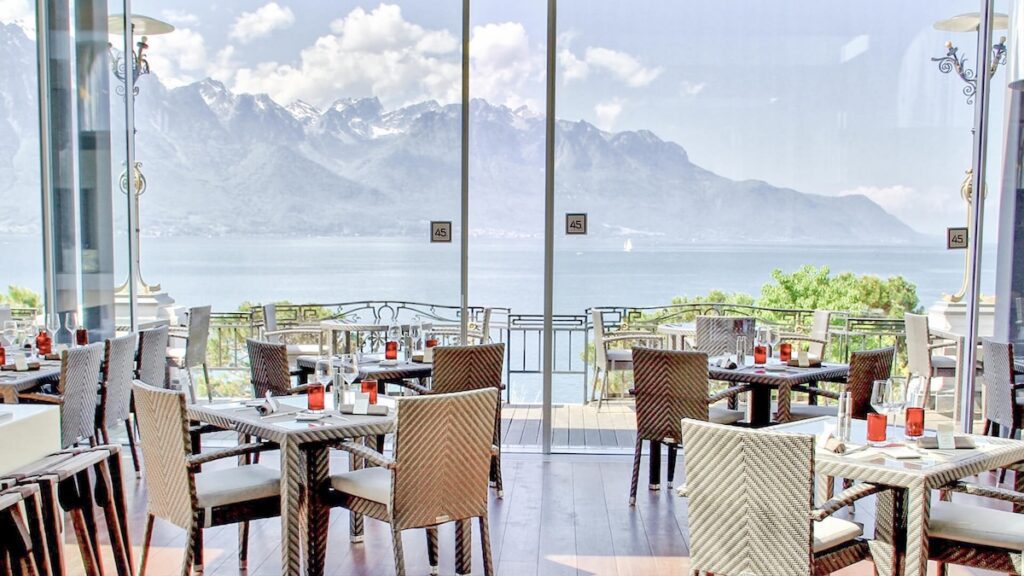
Why would Ms. Franklin and Mr. King have been here?…for the world-famous Jazz Festival of course. Started in 1967 by Claude Nobbs, the cream of musical royalty has performed here: Miles Davis, Ella Fitzgerald, Pink Floyd, Van Morrison, Dizzy Gillespie, Etta James, and Deep Purple, who infamously wrote ‘Smoke on the Water’ after an overenthusiastic pyrophile fan torched the Casino where Frank Zappa was performing.
Queen, singular
But the greatest phantom still haunting Montreux thirty-three years after his death is Freddie Mercury. Queen made six albums here, and he found peace in his waterfront apartment. Muttering under my old-cynical journalist’s breath about “cashing in,” and “exploiting gullible fans,” I reluctantly joined a ‘Freddie Tour’ in the pouring rain. It was captivating and very moving. Truly ‘A Kind of Magic.’ The tour ended at the water’s edge with the larger-than-life-size bronze of Freddie, much photographed, the focus of fans’ pilgrimages.
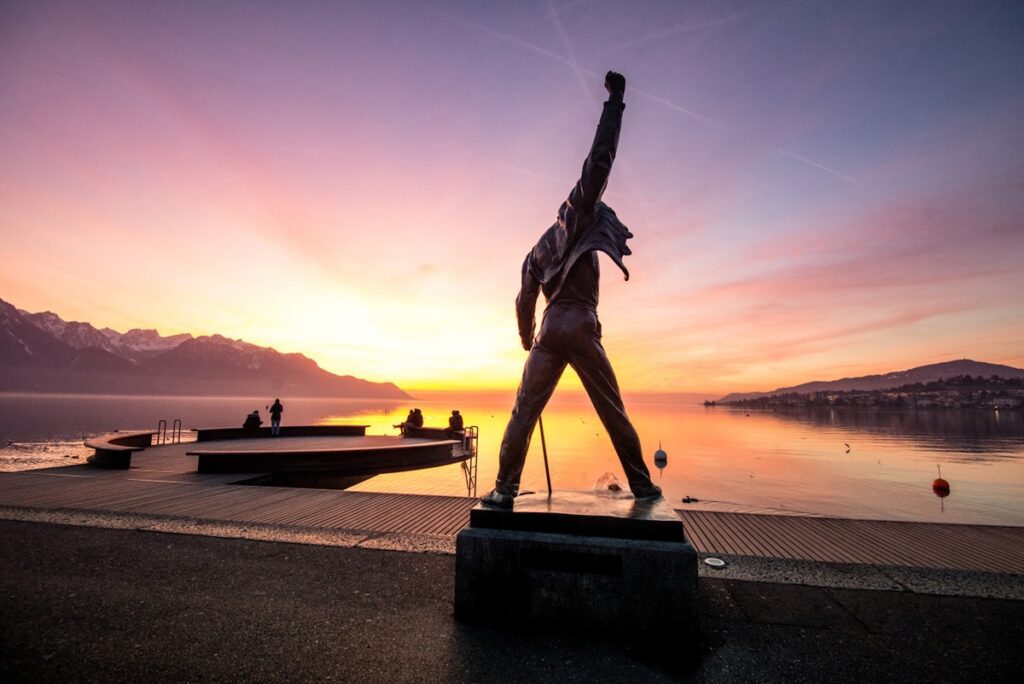
The Hush of Wealth
Bidding au Revoir to Montreux, I hopped aboard the Golden Pass Express with its deep armchairs and huge windows to sip champagne and eat caviar as we journeyed onwards, and upwards. The track climbed past the late Claude Nobbs’s chalet (a museum now, jampacked with vintage guitars, Harley-Davidsons, a 50s jukebox with genuine discs – Elvis, Muddy, Jerry Lee – and a small cinema, seating courtesy Virgin Atlantic Upper Class).
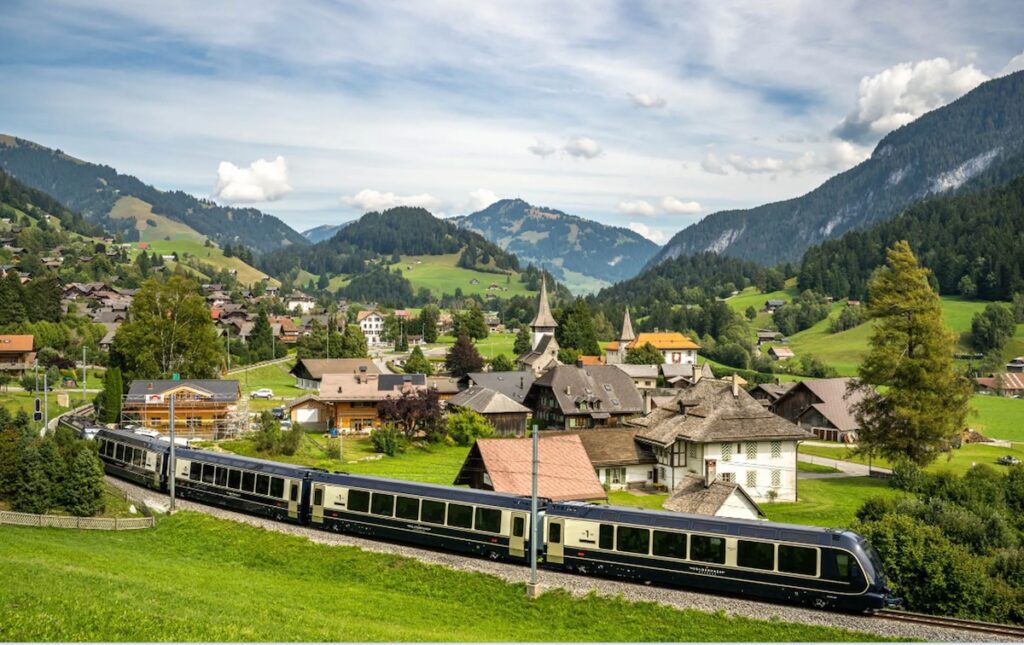
Sliding by as in a dream, Château-d’Oex with its annual posh hot-air balloon festival; change for Gruyère and its holey cheese…Switzerland, the ‘Land of Milk and Money’; next stop Gstaad bathed in the unmistakable hush of wealth, where the money settles. (Chalets here …not ‘houses’…yours for £11 million). I checked discreetly out of the window for a glimpse of residents; Madonna out shopping, octogenarian Julie Andrews picking up meds in the chemist, or the tiny Bernie Ecclestone popping into the newsagents for his What Car? Magazine, but no one left, and no one came on the bare platform.
Marcella’s tiffin
Somewhere between Montreux and Spiez, our stop for the night, we crossed the invisible French/German linguistic boundary, the Rösti Line, where Rösti (fried spuds) replaces Raclette (melted cheese) in popularity. As it was 4.00 o’clock I enquired of our carriage manager Marcella if she could rustle up something typically British for tiffin. She magicked me a warm muffin. Absolutely Tip-Top.
Co-op Wines
The train traveller to Switzerland cannot but notice the vines which cover every suitable parcel of land. From the Valais’s Chasselas variety, we were now in the Bernese Oberland and surrounded by Reisling-Sylvaner grapes. The cellars of Alpine Weinkultur Spiezer, a cooperative dedicated to growing and tasting wine, were a short walk from the station. We embarked on a liquid tour under the genial guidance of Paul who provocatively declared, “We don’t make wine of Chasselas, we eat the grapes!”.
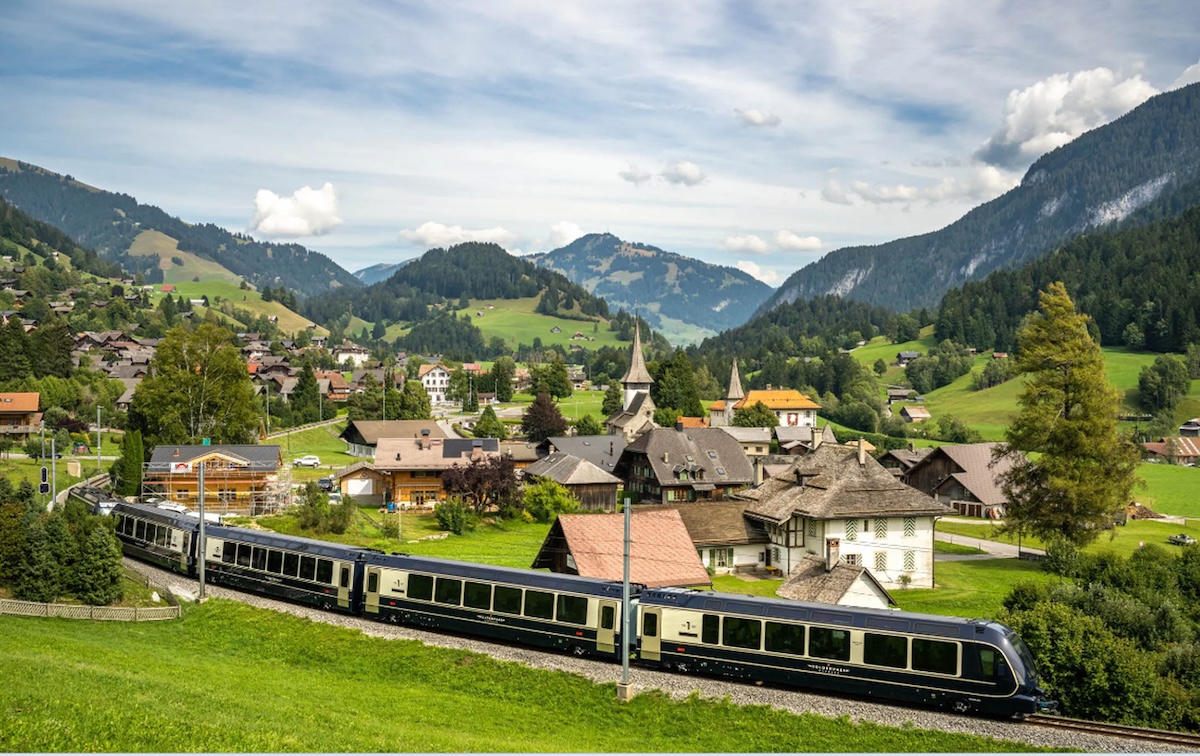
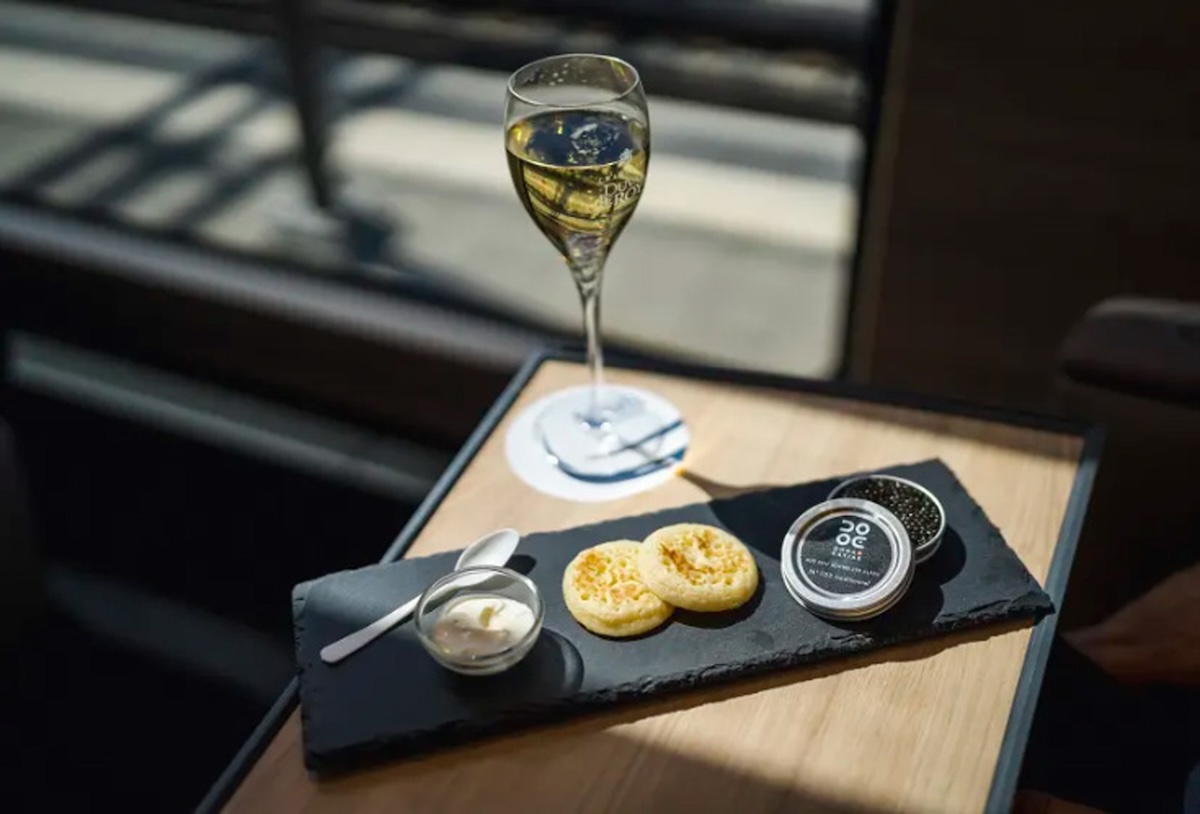
I took notes but interpreting them in the cold light of day is tricky. What I am certain of is that they make jolly fine wine. I bought a bottle of their Cuvée ‘Intro Barrique’ with ‘notes of prune, dark cherries, pepper, tobacco, and vanilla. A fine accompaniment to meals with lamb, ragout, hearty vegetarian dishes and a good book on long evenings’. Tobacco?! Whoever wrote their copy deserves an award.
Trains and Boats and Blueberry Pie
From the balcony of the Hotel Belvédère, Belle Époque and utterly delightful, I overlooked Lake Thun, the town and landing stage, a clue to the next episode of the Grand Train Tour, a boat trip – what else. As a guest of Swiss Railways, I had a Swiss Travel Pass with unlimited travel by train, bus and boat.
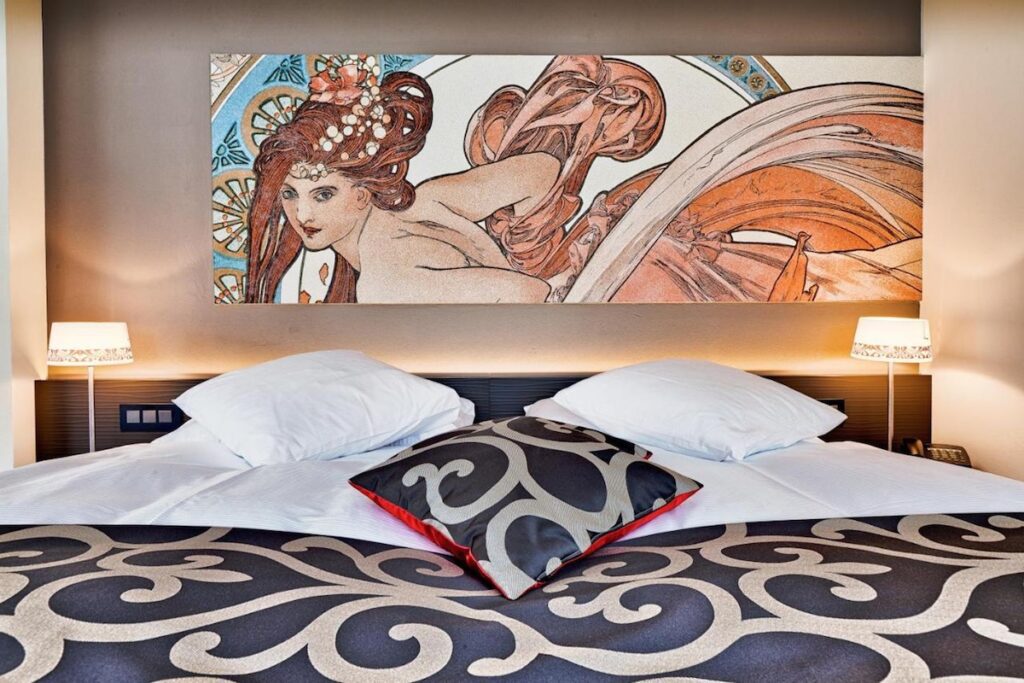
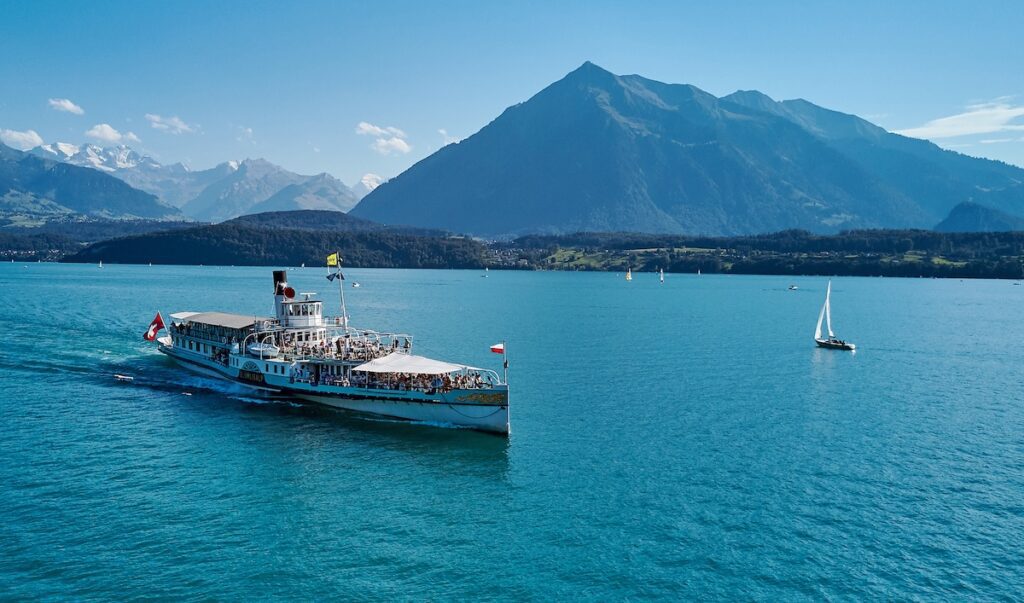
As I settled into the elegant lounge of our launch and tackled elevenses – a fresh slice of blueberry pie and a hot chocolate, the silhouette of the 2,360m pyramidical Mount Niesen loomed with its cog railway to the summit alongside the world’s longest staircase with 11,674 steps. FYI the current record for running (yes, running) up it is 57 mins 22 secs. I held that thought and finished my blueberry pie.
Swiss Efficiency and the Mother Clock
We disembarked at Interlaken West, hopped on an interconnecting train for the short trip to Interlaken Ost and thence to our Express for Lucerne with just time to gaze in awe at the mighty trinity of Eiger, Mönch and Jungfrau away in the distance, each shrouded in a snowy cowl. Transitioning between modes of transport is so simple it is easy to forget the brilliance of the system.
All railways in Switzerland are electric, derived from 90% hydropower. Schedules are synchronised from the Mutter Uhr – Mother Clock – in Bern. Under a regular interval timetable, trains arrive and depart each station at the same minute after every hour or half hour, guaranteeing systematic, recurring connection times.
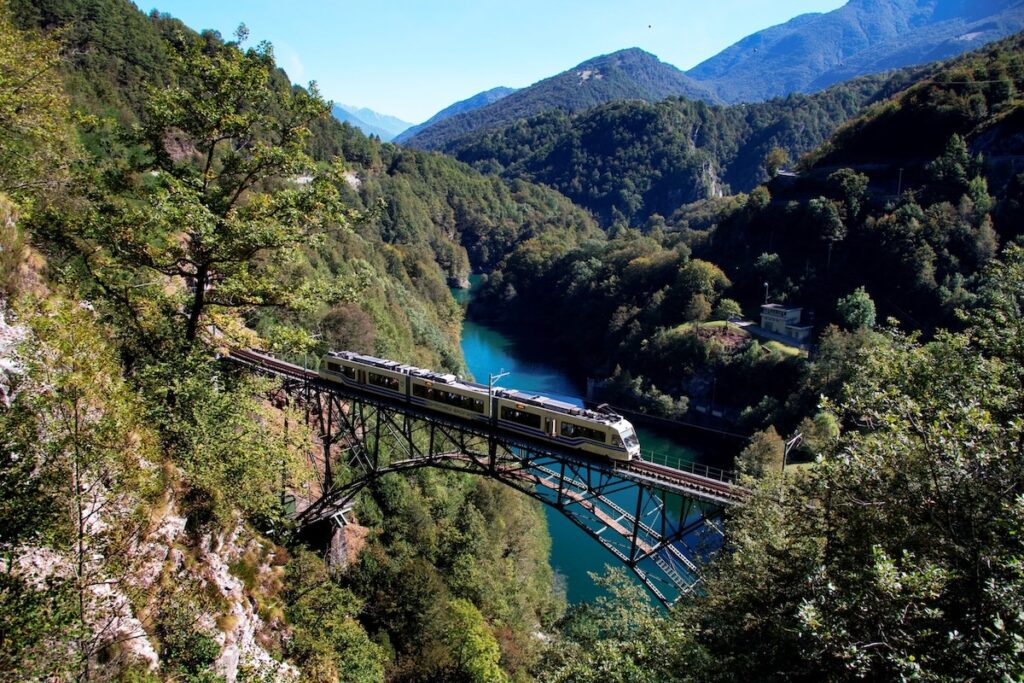
Boats, buses, and Postbuses (all covered by the Travel Pass) mesh seamlessly with these timings. Hundreds of individual companies operate under the umbrella of Swiss Federal Railways, a miracle of Swiss efficiency. Andy Nef, marketing manager for Swiss Railways advised me to “Sit on the right side for the best views.” Andy was born with “iron in my blood” in the tiny Lichtensteig Station house, his dad was the Station Master, mum sold tickets. What he doesn’t know about railways isn’t worth knowing. He’s a self-confessed rail nerd (but lovely with it). His advice was spot on.
Through our wrap-over carriage windows, we saw the Reichenbach Falls cascading above Meiringen where Sherlock Holmes battled his nemesis Professor Moriarty to their deaths. Though fictitious, six million visitors a year pay homage at the museum in the village. A nice little earner. Our train swooshed on, smoother than a Michael Bublé ballad, over the magnificent Brünig pass, skirting lake after lovely lake, Brienz, Lungersee, Sarnersee, and finally into Lucerne.
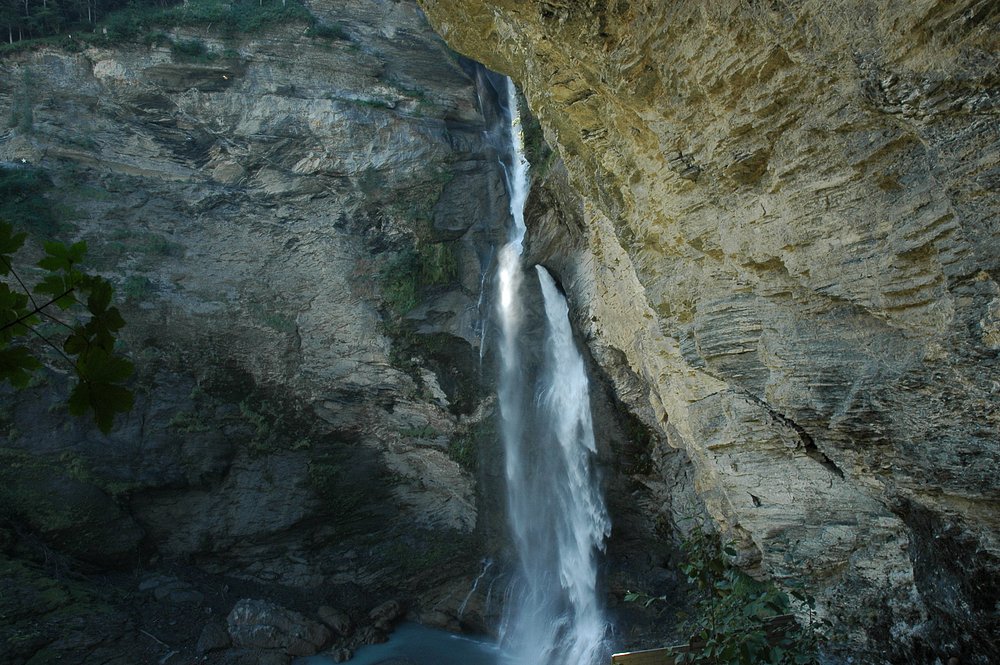
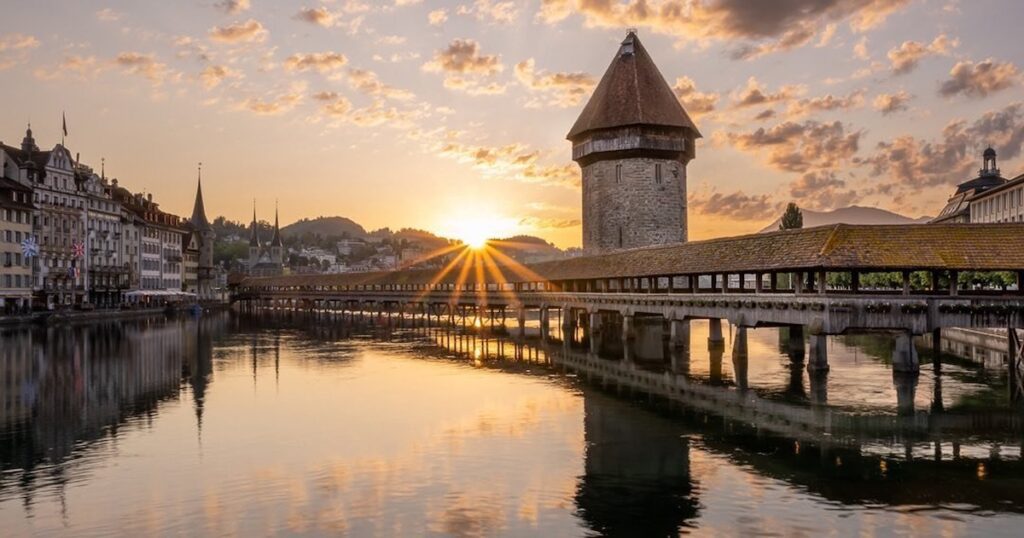
With some free time, it was a chance to see a few of the must-see sights, the prime one being the iconic Chapel Bridge, a covered wooden footbridge spanning the River Reuss originally built in 1365, once frequented by ladies of easy virtue, but now an Instagram favourite after prostitution became legal in 1942. Ironically, votes for women only became federal law in 1971.
Toot Toot
She bobbed at the quayside, waiting, Swiss flag fluttering from her stern, the tendrils of smoke from her funnel whipped away by the stiff breeze; the stately Stadt Luzern. Built-in 1928 as the last Swiss lake paddle steamer, she hosted our late Queen in 1980. As I settled in the elegant Art Deco saloon the captain signaled with a toot toot! and we cast off for Flüelen, taking a civilized lunch aboard – lake perch and mash with a bottle of local Urbräu beer – then a turn around the lower deck, past throbbing pistons and huge red paddles, as we steamed close by a sacred spot, Rütliwiese, site of the foundation of Switzerland.
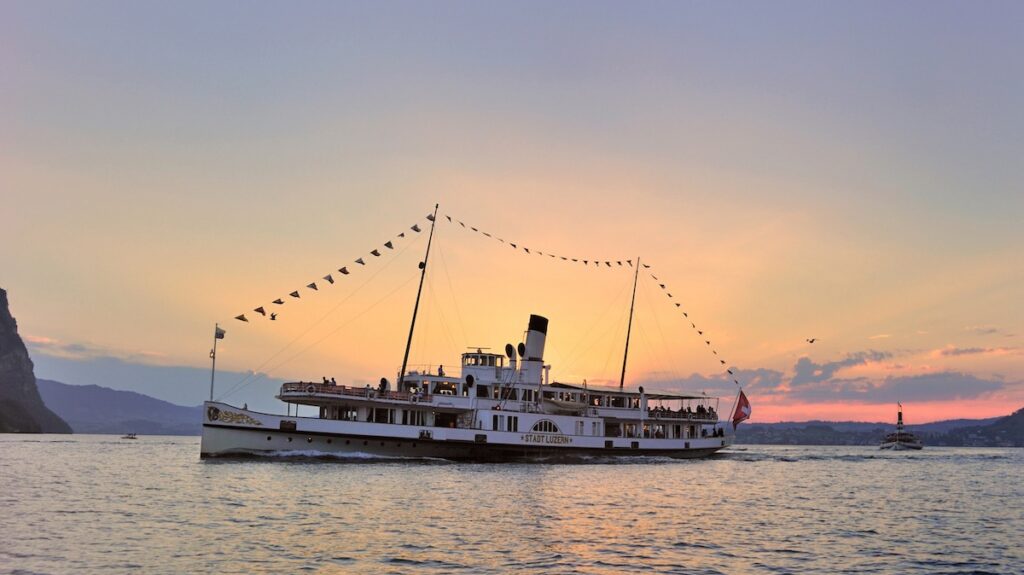
Ghosty Gotthard
An immaculate train was waiting at Flüelen, liveried in the white, black, red and gold of the Gotthard Panorama Express, for the longest leg of our voyage from the heart of Switzerland to Bellinzona in its deep south. And, waiting at the door, clad in a sharp grey three-piece suit, was tour guide Herr Eric Bukkofer. The carriage was a cross between a private member’s club and Jules Verne’s submarine Nautilus from ‘20,000 Leagues Under the Sea’ – deep armchair seating, and floor-to-ceiling windows.
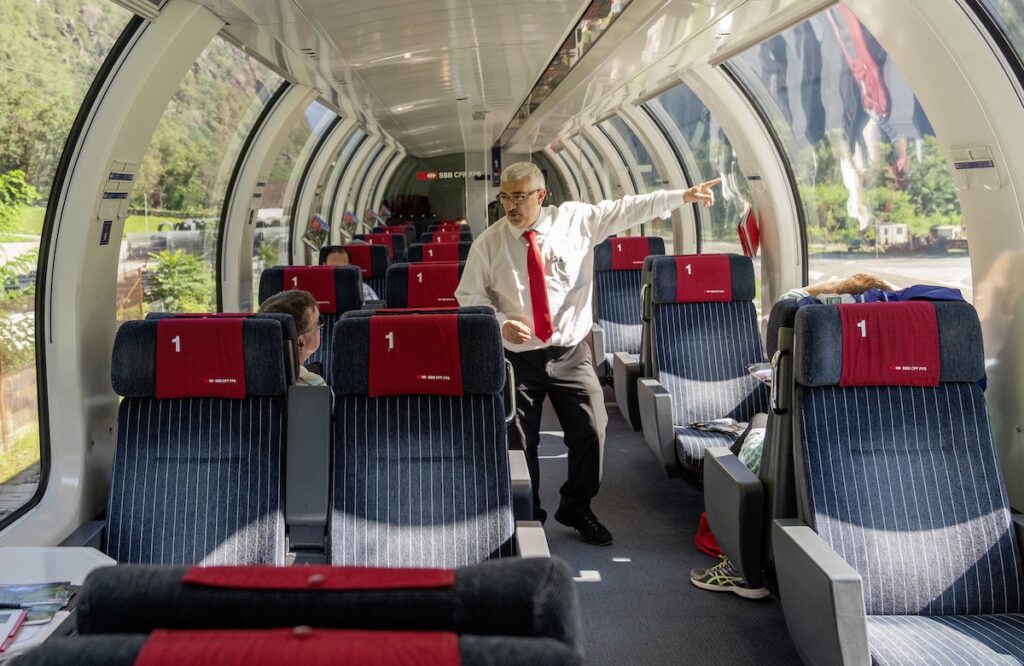
Eric talked through our Top Trumps trip as he ushered us into the adjoining carriage with its opening windows. We entered the Gotthard Base, the world’s longest, 57 kilometres, and deepest, 2,450 metres. The train slowed as an audio-visual display told the story of the construction, and there, sitting in an aisle seat was the ghostly figure of engineer Louis Favre who died on the job, but he wasn’t very chatty just then.
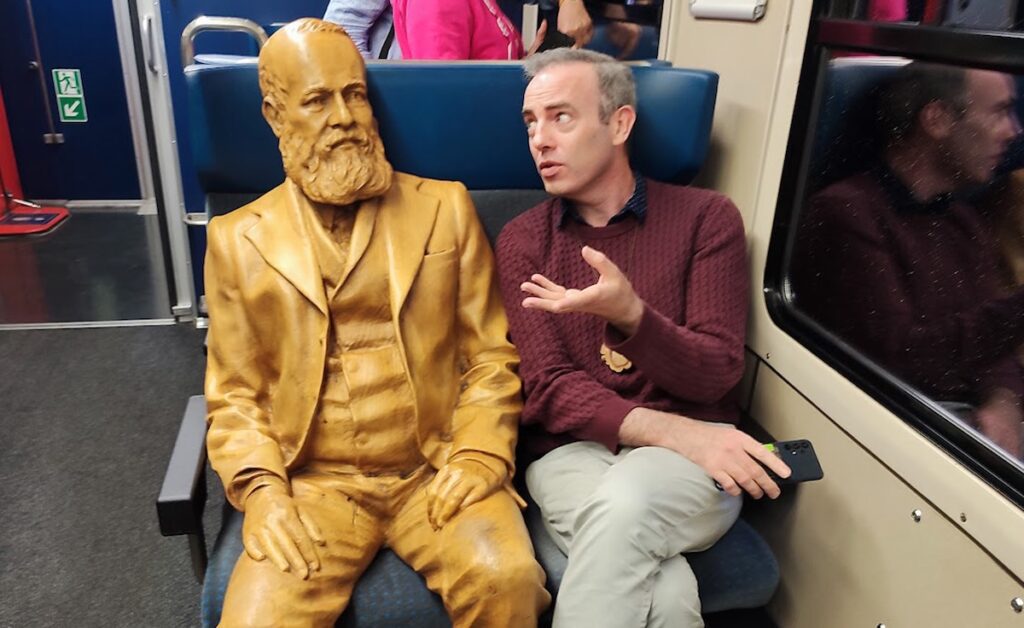
Back into the sunlight and, as the ascending track looped three times around the pretty village of Wassen, Eric warned, “Look out of the left-hand side!” and there was a local landmark, Xavier, waving a huge Swiss flag at us. He does it at each passing express for fun and national pride.
Branch Line and a Birra Boz
A change to a local train at Bellinzona deposited us in Locarno for the night, gloriously Mediterranean in culture with a language flip to Italian, the local wine the astonishing White Merlot. I fell asleep to the sound of Lake Maggiore lapping the shore. A short bus ride (all covered on my Swiss Travel Pass) to the station for a rendezvous with the charming Centovalli Railway to Domodossola.
With echoes of branch lines of long ago, the railway rickets and rackets its way along a narrow-gauge single-track through chestnut woods, over spindly bridges spanning yawning gorges, creaking to a halt at tiny villages. As we pootled on, I munched on a panino al tonno with a bottle of Birra Boz to wash it down a reminder that I was temporarily in Italy. Change at Domodossola and into Switzerland, slap back in the epicentre of the wine-growing region of the Valais with its Fendant variety.
Grand Wine for a Grand Trip
Last night in Sion, circled by snow-capped peaks, and a final wine sampling at Celliers de Sion, where the famous dynasties of Varone and Bonvin have combined to create an Œnoparc where customers can taste, buy and learn about Valais wine. The futuristic building, using 95% solar power, is accessed by bus, and visitors can e-bike around the vineyards tasting as they go. Pinot Noir and Chasselas vines cling to the near-vertical hillside. After an in-depth tasting, I splashed out on a Cuvee 1858, Rouge AOC Valais, at £50, a Grand wine and fitting souvenir of my Grand Train Tour of Switzerland.
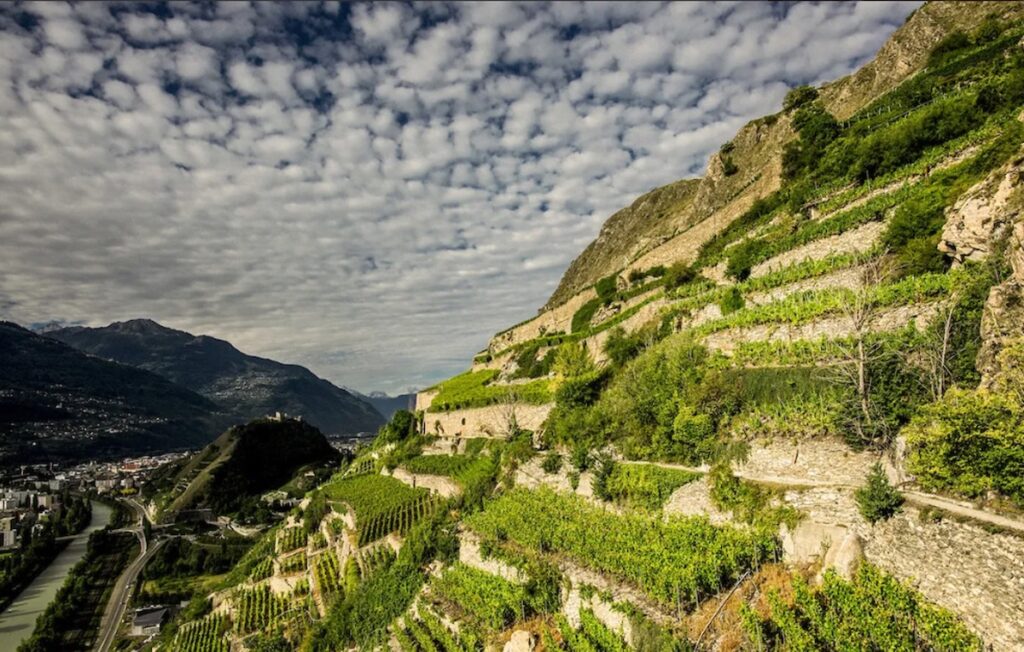
Travel Switzerland provides a range of exclusive travel passes and tickets for visitors from abroad. The Swiss Travel Pass offers unlimited travel on consecutive days throughout Travel Switzerland’s rail, bus and boat network, and also covers scenic routes and local trams and buses in around 90 towns and cities, and includes the Swiss Museum Pass, with free entrance to 500 museums and exhibitions. Prices from £186 for a three-day second-class ticket. For more information on the Grand Train Tour of Switzerland, visit travelswitzerland.com #travelswitzerland #grandtraintour
